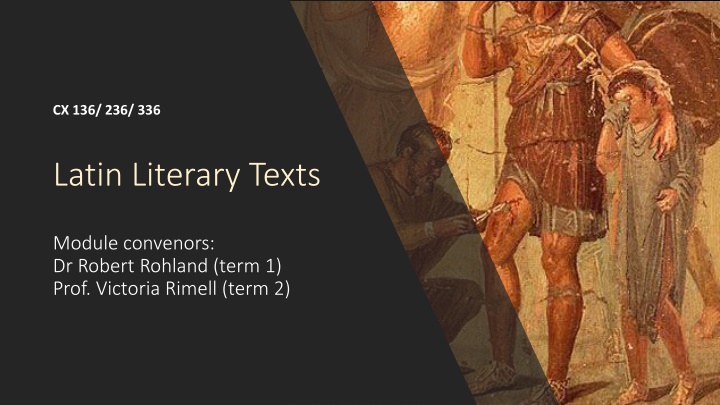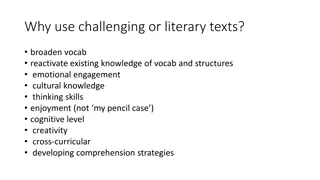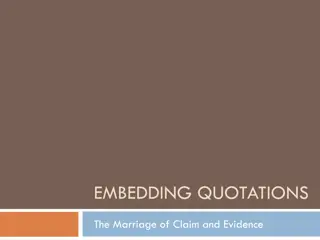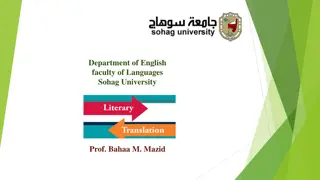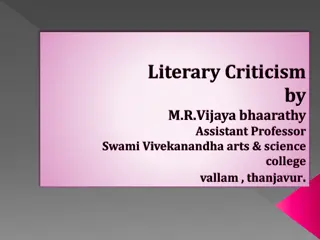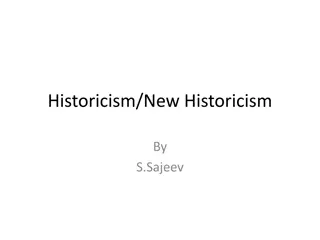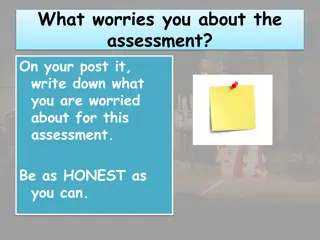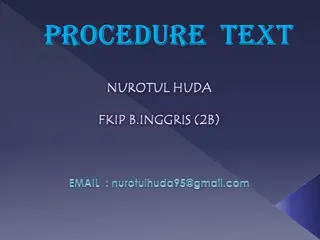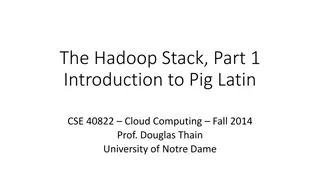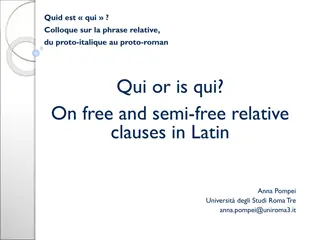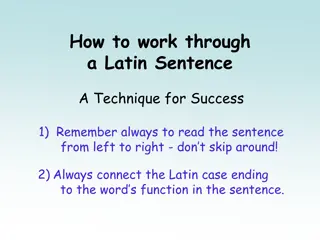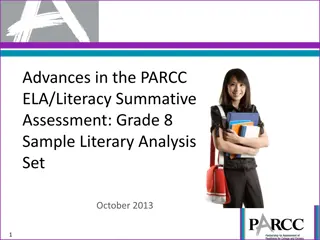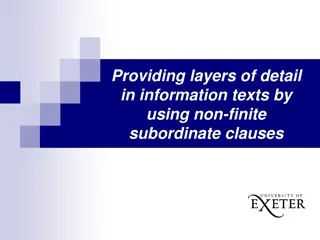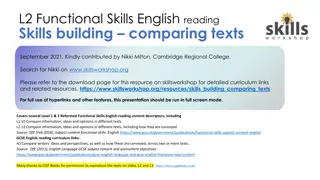Latin Literary Texts Module Overview
This module provides an advanced study of Latin grammar and literary texts by Virgil, Cicero, and Sallust. Students will develop translation skills, critical analysis, and thematic understanding. The set texts include Virgil's Aeneid 12, Sallust's Bellum Catilinae, and Cicero's Catilinarians. Recommended resources include dictionaries and grammars. Expect a challenging learning curve, but utilize office hours for extra help and guidance.
Download Presentation

Please find below an Image/Link to download the presentation.
The content on the website is provided AS IS for your information and personal use only. It may not be sold, licensed, or shared on other websites without obtaining consent from the author.If you encounter any issues during the download, it is possible that the publisher has removed the file from their server.
You are allowed to download the files provided on this website for personal or commercial use, subject to the condition that they are used lawfully. All files are the property of their respective owners.
The content on the website is provided AS IS for your information and personal use only. It may not be sold, licensed, or shared on other websites without obtaining consent from the author.
E N D
Presentation Transcript
CX 136/ 236/ 336 Latin Literary Texts Module convenors: Dr Robert Rohland (term 1) Prof. Victoria Rimell (term 2)
an advanced and comprehensive knowledge of Latin grammar an appreciation of the history of the Latin language an appreciation of the different styles of Virgil, Cicero and Sallust the ability to translate set texts independently, and with growing fluency the ability to interpret and discuss critically aspects of the set texts and of some secondary bibliography an awareness of how the thematic concerns of the individual books studied relate to the authors work as a whole the ability to translate previously unprepared passages from the set authors Aims You ll (slowly but surely) develop
The set texts, and which books to buy Set Text 1: Virgil Aeneid 12 (term 1) Set Text 2: Sallust, Bellum Catilinae (the first 5 weeks or so of term 2) Set Text 3: Cicero, Catilinarians 1 (the remainder of term 2) [You ll be expected to read all of the Aeneid and Cicero s Catilinarians in English) It s essential to buy the following: R. Tarrant, Virgil Aeneid Book XII, Cambridge, 2012 (bring to all term 1 classes!) J.T. Ramsey, Sallust s Bellum Catilinae, 2nd edition, Oxford 2007 A.R. Dyck, Cicero Catilinarians, Cambridge, 2008
The tools Recommended Dictionaries: Charles Lewis and Charles Short, A Latin Dictionary (Oxford, various reprints) or C.T. Lewis, An Elementary Latin Dictionary, Oxford 2002 Recommended Grammars: James Morwood, A Latin Grammar (Oxford, 1999) or Cambridge Latin Grammar (Cambridge, 1992) or Kennedy s Revised Latin Primer (1995) Note that the Lewis & Short is also available as a smartphone app for around 4, and can be consulted online on perseus.tufts.edu. Also try, if you can, to use the Oxford Latin Dictionary, regarded as the best Latin-English dictionary available (copies available for consultation in the University Library).
Learning curve It s a steep one! Remember everyone comes to this module with differing levels of knowledge. It s going to take a few weeks to find your rhythm, so stay focused, don t panic, and if in doubt, ask for help that s what we re here for! We invite you to use our office hours as extra teaching time
What you should expect In the weekly class, you ll be asked to prepare a bit more Latin than can reasonably be covered in class. We won t necessarily always translate round the class . If you received a correct translation of set texts from your teachers at school, you ll need to adjust to the idea that a) there is no one correct, or best, translation of your texts (that s what s interesting!) and b) the point of studying Latin at this level is to develop fluency in reading it by yourself. You might feel it takes up a disproportionate amount of time to prepare for each class, relative to your other modules. But remember, there is no coursework for LLT, so it all comes out in the wash in the end! Overall, you should expect to do around 4 hours independent work each day, outside of lectures, seminars and classes. You might well spend quite a few hours preparing your set text every week, so be prepared to manage your time accordingly.
Establishing university-level study skills It s a good idea to write out your own translation, but don t get too attached to *the* translation; attempt to keep your focus on the Latin text, and mark up the text itself in pencil to help clarify your understanding of each sentence as you read and re-read the Latin. Avoid revising by just reading your translation. It s fine if you want to use a fairly literal translation (such as the Loeb) to help you understand the set text. BUT, try not to use the translation as a crutch. Be honest with yourself as you work: do I really understand how this sentence fits together? Is the syntax and grammar clear? Does it reveal anything I don t yet know, or should revise? If in doubt, ask. You are not meant to know everything already!!! Keep a vocab list, and if you don t know the principle parts of a verb, look them up and write them down. Work hard (little but often) on building up your familiarity with the sounds, shapes and sense-structures of literary Latin. These texts are not complicated crossword puzzles to be solved . Read your set texts aloud. Practice daily by reading short passages of easier Latin.
How to use an academic commentary From the blurb of Cambridge green and yellows : The commentaries discuss texts as works of literature while providing all the guidance needed by today's student. A commentary is not a textbook or a solution sheet: don t use the commentary only as an aid to arrive at the correct translation. Occasionally a commentator translates whole lines/phrases. Avoid just copying these phrases and jumping to the next line. Using a commentary will enrich your reading experience on multiple levels. Make sure to read the introduction. And be aware of the list of abbreviations (this can demystify many things). The Aeneid 12 commentary contains helpful discussions on every major section. Make sure to read these. A commentary is not the last word on the text: you can follow up reading suggestions from the commentary (we will look at some further readings in our classes).
